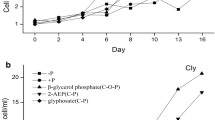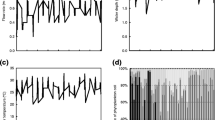Abstract
Pico-cyanobacteria and micro-cyanobacteria coexist ubiquitously in many lakes. Differences in cell size and abilities to utilize nutrients may influence their distribution patterns. In this study, Synechococcus sp. and Microcystis aeruginosa were chosen as pico- and micro-cyanobacteria, respectively. Gradient phosphorus treatments (0.002, 0.01, 0.05, and 0.25 mg P L−1) were designed in mono- and co-cultures. Growth curves were recorded and fitted by the Monod equation. Moreover, the interspecific competition was analyzed by the Lotka–Volterra model. When mono-cultured in lower P conditions (≤ 0.01 mg P L−1), Synechococcus sp. obtained much higher biomass than M. aeruginosa. But, M. aeruginosa grew faster than Synechococcus sp. in higher P groups (≥ 0.05 mg P L−1) (p < 0.05). Synechococcus sp. has abilities to thrive in low-phosphorus environments, whereas M. aeruginosa favored high-phosphorus conditions. In co-cultures, Synechococcus sp. strongly inhibited M. aeruginosa at each P treatment.




Similar content being viewed by others
References
Barber RT (2007) Picoplankton do some heavy lifting. Science 315:777–778
Berkson J (1944) Application of the logistic function to bio-assay. J Am Stat Assoc 39:357–365
Björkman K, Duhamel S, Karl DM (2012) Microbial group specific uptake kinetics of inorganic phosphate and adenosine-5′-triphosphate (ATP) in the north Pacific subtropical gyre. Front Microbiol 3:1–17
Brookes JD, Ganf GG (2001) Variations in the buoyancy response of Microcystis aeruginosa to nitrogen, phosphorus and light. J Plankton Res 23:1399–1411
Cade-Menun BJ, Paytan A (2010) Nutrient temperature and light stress alter phosphorus and carbon forms in culture-grown algae. Mar Chem 121:27–36
Cai Y, Kong F (2013) Diversity and dynamics of picocyanobacteria and the bloom-forming cyanobacteria in a large shallow eutrophic lake (Lake Chaohu, China). J Limnol 72:473–484
Callieri C, Caravati E, Corno G, Bertoni R (2012) Picocyanobacterial community structure and space-time dynamics in the subalpine lake Maggiore (Italy). J Limnol 71:95–103
Danish Standard (2004) Water quality: determination of phosphorus—ammonium molybdate spectrometric method. DS/EN ISO 6878:2004. Danish Standard, Copenhagen
Duan Z, Tan X, Parajuli K, Upadhyay S, Zhang D, Shu X, Liu Q (2018) Colony formation in two Microcystis morphotypes: Effects of temperature and nutrient availability. Harmful Algae 72:14–24
Elshanawany R, Zonneveld KAF (2016) Dinoflagellate cyst distribution in the oligotrophic environments of the Gulf of Aqaba and northern Red Sea. Mar Micropaleontol 124:29–44
Eppley RW, Rogers JN, Mccarthy JJ (1969) Half saturation constants for uptake of nitrate and ammonium by marine phytoplankton. Limnol Oceanogr 14:912–920
Feng L, Liu S, Wu W, Ma J, Li P, Xu H, Li N, Feng Y (2016) Dominant genera of cyanobacteria in lake Taihu and their relationships with environmental factors. J Microbiol 54:468–476
Fukuda R, Ogawa H, Nagata T, Koike II (1998) Direct determination of carbon and nitrogen contents of natural bacterial assemblages in marine environments. Appl Environ Microbiol 64:3352–3358
Fuller NJ, West NJ, Marie D, Yallop M, Rivlin T, Post AF, Scanlan DJ (2005) Dynamics of community structure and P status of picocyanobacterial populations in the Gulf of Aqaba, Red Sea during 1999–2000. Limnol Oceanogr 50:363–375
Havens KE, Jin KR, Iricanin N (2007) Phosphorus dynamics at multiple time scales in the pelagic zone of a large shallow lake in Florida, USA. Hydrobiologia 581:25–42
Imai H, Chang K, Kusaba M, Nakano S (2009) Temperature-dependent dominance of Microcystis (Cyanophyceae) species: M. aeruginosa and M. wesenbergii. J Plankton Res 31:171–178
Ji Y, Sherrell RM (2008) Differential effects of phosphorus limitation on cellular metals in Chlorella and Microcystis. Limnol Oceanogr 53:1790–1804
Karl DM (2002) Nutrient dynamics in the deep blue sea. Trends Microbiol 10:410–418
Kolmakov VI (2006) Methods for prevention of mass development of the cyanobacterium Microcystis aeruginosa Kutz emend. Elenk. in aquatic ecosystems. Mikrobiologiia 75:149–153
Kolmonen E, Sivonen K, Rapala J, Haukka K (2004) Diversity of cyanobacteria and heterotrophic bacteria in cyanobacterial blooms in Lake Joutikas Finland. Aquat Microb Ecol 36:201–211
Latour D, Giraudet H, Berthon JL (2004) Frequency of dividing cells and viability of Microcystis aeruginosa in sediment of a eutrophic reservoir. Aquat Microb Ecol 36:117–122
Li M, Zhu W, Gao L, Lu L (2013) Changes in extracellular polysaccharide content and morphology of Microcystis aeruginosa at different specific growth rates. J Appl Phycol 25:1023–1030
Ma J, Brookes JD, Qin B, Paerl HW, Gao G, Wu P, Zhang W, Deng J, Zhu G, Zhang Y, Xu H, Niu H (2014) Environmental factors controlling colony formation in blooms of the cyanobacteria Microcystis spp. in Lake Taihu, China. Harmful Algae 31:136–142
Mahaffey C, Björkman KM, Karl DM (2012) Phytoplankton response to deep seawater nutrient addition in the North Pacific Subtropical Gyre. Mar Ecol Prog Ser 460:13–34
Mao H, Xu H, Liu ZP, Mehta SK (2008) Effect of initial cell density on population competition between Skeletonema costatum and Chaetoceros curvisetus. Mar Environ Sci 27:458–461
Marinho MM, Souza MB, Lurling M (2013) Light and phosphate competition between Cylindrospermopsis raciborskii and Microcystis aeruginosa is strain dependent. Microb Ecol 66:479–488
Martiny AC, Huang Y, Li W (2009) Occurrence of phosphate acquisition genes in Prochlorococcus, cells from different ocean regions. Environ Microbiol 11:1340–1347
Monbet P, Mckelvie I, Saefumillah A (2007) A protocol to assess the enzymatic release of dissolved organic phosphorus species in waters under environmentally relevant conditions. Environ Sci Technol 41:7479–7485
Monod J (1950) La technique de culture continue: théorie et applications. In: Lwoff A, Ullmann A (eds) Selected papers in molecular biology by jacques monod. Academic Press, New York, pp 184–204
Mountain T, Thingstad TF, Wambeke FV, Marie D, Slawyk G, Raimbault P, Claustre H (2002) Does competition for nanomolar phosphate supply explain the predominance of the cyanobacterium Synechococcus?. Limnol Oceanogr 47:1562–1567
Mulder C, Hendriks AJ (2014) Half-saturation constants in functional responses. Global Ecol Conserv 2:161–169
Paerl HW (2008) Nutrient and other environmental controls of harmful cyanobacterial blooms along the freshwater-marine continuum. Adv Exp Med Biol 619:217–237
Raven JA (1998) The twelfth tansley lecture, small is beautiful: the picophytoplankton. Funct Ecol 12:503–513
Riebesell U, Wolf-Gladrow DA (2002) Supply and uptake of inorganic nutrients. In: Williams PJ le Thomas B, Reynolds DN, C.S., (eds) Phytoplankton productivity: carbon assimilation in marine and freshwater ecosystems. Blackwell Science Ltd, Oxford, pp 78–108
Sarmento H, Unrein F, Isumbisho M, Stenuite S, Gasol JM, Descy JP (2008) Abundance and distribution of picoplankton in tropical, oligotrophic Lake Kivu, eastern Africa. Freshw Biol 53:756–771
Tambi H, Flaten GAF, Egge JK, Bødtker G, Jacobsen A, Thingstad TF (2009) Relationship between phosphate affinities and cell size and shape in various bacteria and phytoplankton. Aquat Microb Ecol 57:311–320
Vadstein O (2000) Heterotrophic, planktonic bacteria and cycling of phosphorus. Adv Microb Ecol 16:115–167
Vaulot D, Lebot N, Marie D, Fukai E (1996) Effect of phosphorus on the Synechococcus cell cycle in surface Mediterranean waters during summer. Appl Environ Microb 62:2527–2533
Verity PG (1992) Relationships between cell volume and the carbon and nitrogen content of marine photosynthetic nanoplankton. Limnol Oceanogr 37:1434–1446
Vollenweider RA, Kerekes J (1982) Eutrophication of waters. monitoring assessment and control. Organization for Economic Co-Operation and Development (OECD), Paris, 156 pp
Volterra V (1926) Fluctuation in the abundance of a species considered mathematically. Nature 118:558–560
Xiao M, Willis A, Burford MA (2017) Differences in cyanobacterial strain responses to light and temperature reflect species plasticity. Harmful Algae 62:84–93
Xiao M, Li M, Reynolds CS (2018) Colony formation in the cyanobacterium Microcystis. Biol Rev 93:1399–1420
Ye W, Tan J, Liu X, Lin S, Pan J, Li D, Yang H (2011) Temporal variability of cyanobacterial populations in the water and sediment samples of Lake Taihu as determined by DGGE and real-time PCR. Harmful Algae 10:472–479
Acknowledgements
This work was supported by National Natural Science Foundation of China (31470507), the Fundamental Research Funds for the Central Universities (2019B14014), the National Water Pollution Control and Treatment Science and Technology Major Project (2017ZX07603) and the project funded by the Priority Academic Program Development of Jiangsu Higher Education Institutions (PAPD).
Author information
Authors and Affiliations
Corresponding author
Rights and permissions
About this article
Cite this article
Tan, X., Gu, H., Zhang, X. et al. Effects of Phosphorus on Interspecific Competition between two cell-size Cyanobacteria: Synechococcus sp. and Microcystis aeruginosa. Bull Environ Contam Toxicol 102, 231–238 (2019). https://doi.org/10.1007/s00128-018-2527-x
Received:
Accepted:
Published:
Issue Date:
DOI: https://doi.org/10.1007/s00128-018-2527-x




